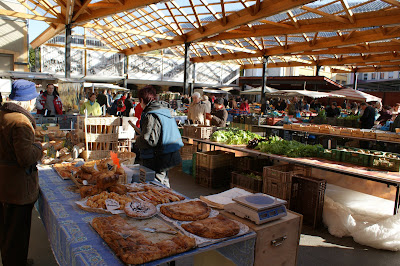If it weren't for the darned train strike, I would have never have known.
(Were it not for the train strike, I wouldn't have been here to blog about the Severed Head of Spring.)
But there is a strike, as there so often is, and my plans to arrive late at a little conference turned into being so very late it wasn't worth going. And, having cleared my weekend for a bit of an outing, here I am at the station in search of whatever looks good.
Tarare looks good, and the woman at the counter says, hey, for 30 euros you can get a card for 25 % off weekdays and 50 % off weekends, for a whole year, for all trains from Auvergne to the Rhone-Alpes region.
Hmmm.
One way to Lyon is 28.
A: the card can pay for itself in just two trips. B: paying for the thing might actually incite me to get off my butt of a weekend and out exploring. Sequencing another hundred samples to find yet again no mutations in Rad50 can wait.
The only drawback is, I have to get my tickets in person here at the station. It's a regional deal, after all, so you can't get the discount on the national train company website. A false problem, really. I should just do like today: take a change of clothes to work with me, and just hop on whatever's leaving. I'll probably get around to making every stop on the Clermont-Lyon line this way, and there are some cool places to see. I can go as far as Chambery, in the Alps, and places I've never considered. Gotta get more maps.
.
The train for Lyon is quite full. It's a shiny new train, happily, not one of the awful wrecks I've so often suffered on.
My fellow passengers appear to be mostly university students heading home for the weekend. They're snacking, chatting on their slick tiny phones, looking at their computer screens. A few are doing homework. The overhead racks are laden with duffel bags, backpacks, cast-off coats.
My seatmate makes his way through several candy bars and a bag of chips while watching music videos on his laptop. At Roanne he packs away the computer to make room for a sandwich, which he cuts from a baguette and a block of cheese. This too he wolfs down, and it's all cleared away by the time I disturb him to exit at Tarare. I hope he makes it home to dinner before starving.
In turning around I see how important it was for everyone to crowd around on the quai waiting for access to the train in Clermont - every square foot of floor space and the steps between the sections of our spiffy car are taken up with young people and their encumbering baggage. More than one girl is eyeing the seat I just vacated, and it's not just for the handsome young man now in the window seat.
.
A handful of people descend at Tarare, the last stop before Lyon. They instantly disappear into the early night. It's just 7:45 and nobody is around. The station and surrounding streets are empty. The traditional hotel and bar adjacent to the station are long closed.
There is a map of the town. It's not so small, and the center is long and narrow. One street downhill, turn left, and you'll get there.
It isn't far, but it's farther than I thought.
A few bars are open, with one or two customers hanging over the bar talking to the owners. Nothing much is serving food. More worrying, there's not a hotel in sight. There'll be something when I get to the center, certainly.
Well, here's the center, and aside from a higher concentration of shops and the narrowing of the streets, it's much like the outskirts. Not much to eat, nowhere to stay. Finally, I see a Logis de France sign, 5 minutes thataway. I go thataway. Reach the edge of town, see another sign Logis de France, 5 minutes. Five minutes in a car. Not on foot.
Wandering around a bit more, it appears to be true: unlike every single other French town I've been to, even towns far smaller than this one, there is no hotel - not even a one-star dive - in the center of town.
.
à suivre...
.
 It's not quite so scary as Okay Airways, but I will be flying Royal Air Maroc twice this week. We have very annoying stopovers in Casablanca going to and from Marrakech. Three hours each way. Plenty of time to get really bored; not enough time to go see that famous city! Arrrrr!
It's not quite so scary as Okay Airways, but I will be flying Royal Air Maroc twice this week. We have very annoying stopovers in Casablanca going to and from Marrakech. Three hours each way. Plenty of time to get really bored; not enough time to go see that famous city! Arrrrr!



 And the rhubarb is coming back from the dead.
And the rhubarb is coming back from the dead.























 In the meantime, I'd really love to find out how to stop Blogger, in its infinite wisdom, from turning my photographs sideways. For this one it may not matter, but sometimes it really does!
In the meantime, I'd really love to find out how to stop Blogger, in its infinite wisdom, from turning my photographs sideways. For this one it may not matter, but sometimes it really does!







